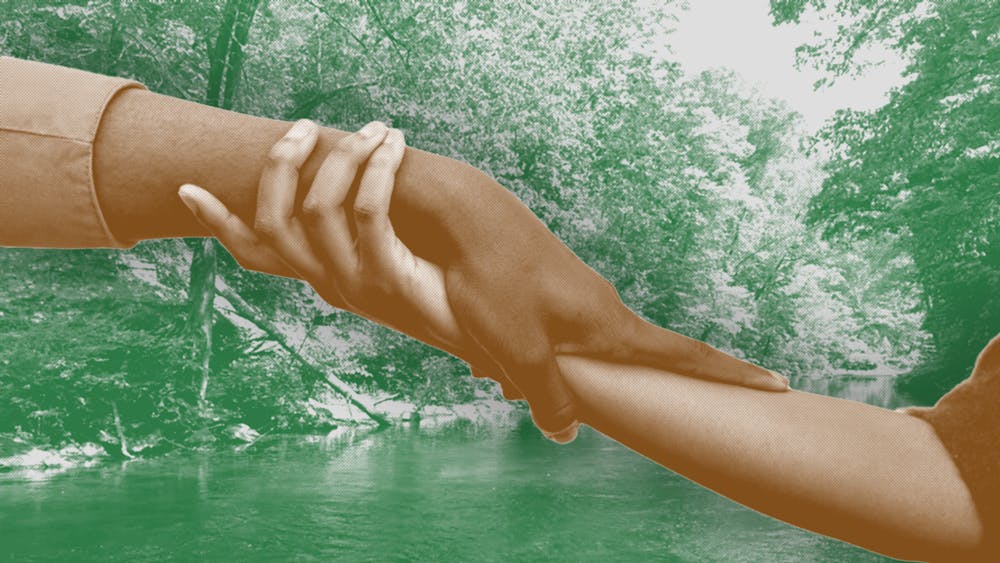Rays of sunlight peek through the canopy and a refreshing breeze rustles the leaves. Gazing further down the trail reveals a vast forest of green pine trees and curious woodland creatures peaking out to say hello. For some students, a scenic hike sounds heavenly, while others recoil at the thought.
Due to prominent stereotypes, people of color are often placed in the latter category. However, diving beyond stereotypes reveals the complicated relationship between POC and the outdoors.
According to a 2019 study by the Outdoor Foundation, 73.7 percent of the average outdoor activity participants in the United States are Caucasian. POC—in more ways than one—are the minority when it comes to the outdoors.
Penn serves as a microcosm where this behavior plays out in real time.
There are various reasons why POC are hesitant to explore outdoor spaces. For instance, the fear of being an outsider can stop an interested student from ever taking the first step. Ennie Akinwunmi (C ‘23) is a Nigerian–American student that loves to camp, hike, kayak, and explore the outdoors.
Despite Ennie’s fondness for the great outdoors, she has reservations about joining nature–centric clubs on campus. This can be a daunting task since Penn is a predominantly white institution where stereotypes of who can enjoy the outdoors are still prevalent. Stereotypes include, but are not limited to, "Black people don’t like the outdoors," "Black people stay in cities or urban areas," "only white people go camping," and many more.
“I was really interested in joining a lot of environmentally focused clubs freshman year, but I also just didn't want my first time camping to be with people I didn’t know. … Seeing other Black people would be a comfort,” says Ennie.
Ennie says, “Being outside is really good for your mental health. There'll be days where I feel really, really bad, and then I'll go outside and go for a walk and I feel much better. I'm also an environmental studies minor, so I like to study the environment in a lot of different contexts.”
This is not to say that nature–centric clubs at Penn have no POC. Instead, POC in these clubs are likely so sparse and spread out that it’s easy to feel alone or like you don’t belong.
“We have to think more about our safety. If we're thinking about things like, OK, if something goes wrong, what's the plan? What's the exit plan like? If someone starts knocking on the tent, what are we doing?” says Ennie.
Another salient concern for POC is their safety. Large outdoor spaces like forests and mountain ranges are usually found in predominantly white and remote areas. For many, the risk of assault or worse isn’t worth communing with nature.
Harrowing stories like that of Vauhxx Booker, a Black man that escaped a lynching attempt while camping in Indiana, highlight the genuine danger that many white environmental enthusiasts at Penn fail to grasp.
Despite the many challenges that POC face when exploring the outdoors, it’s still worth attempting and improving for others. As cliche as it sounds, groups on campus like the Black Student League, South Asian Society, Chinese Student Association, and Pan–Asian American Community House need to be the change they want to see. The stereotype that only white people enjoy the outdoors must be confronted by both POC and white people.
Proactive steps can be taken to slowly integrate students of all backgrounds into outdoors activities. For instance, partnerships between cultural and recreational clubs can allow students to explore the outdoors while surrounded by familiar faces. Additionally, with more POC in outdoor spaces, they can advocate for the safety of themselves and others.
Clubs focusing on the outdoors must also take the initiative to improve diversity. The Penn Outdoors Club (UPOC) is one of Penn’s most prominent outdoor–centric clubs, and they’re actively looking to promote diversity among their ranks, especially by partnering with cultural organizations on campus.
Guthrie Buehler (C ‘24) is the co–president of UPOC and strongly believes that UPOC and the outdoors are for everyone, regardless of race, to enjoy.
“We'd love to partner with the many cultural organizations at Penn. We’d help their members get into the outdoors, whether they are experienced or not,” says Guthrie.
Despite the openness of UPOC, the impact of stereotypes can still be seen in their club membership. The largest demographic is white, followed by Asian, and lastly Black, Hispanic, and Native American.
Guthrie says, "I think a lot of our club is word of mouth. I've had many people come up to me and say they've heard about the club from friends who've gone on a trip or interacted with our club differently.”
Since a majority of club members are white, it’s understandable that they recommend UPOC to their likely white friends—thus unknowingly perpetuating the whiteness of UPOC. This phenomenon highlights that those committed to increasing diversity in outdoor spaces must actively reach out to POC and invite them into existing outdoor spaces.
UPOC has taken substantive measures to make the outdoors accessible to everyone. The cost of participating in outdoor adventures can sometimes be as prohibitive as racial discomfort.
Buying sleeping bags, sleeping mats, tarps, tents, stakes, lamps, hammocks, hiking backpacks, and more can rack up a huge bill.
"UPOC is in a unique position because we have a pretty expensive gear collection that's free for any of our members to borrow," says Guthrie.
Although many people have a deeply complex and not necessarily good relationship with the outdoors, the small changes being made now can make the outdoors better for everyone. For now, we must all take it upon ourselves to make the changes we want to see in the outdoors.







